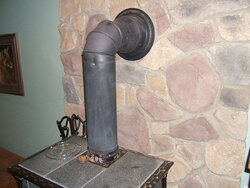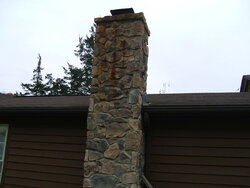I am having a real problem with my wood stove, it won't catch and draw correctly and is smoking like crazy. l cleaned the chimney this fall had two fires without any problems. When I lit the fire the next time the the stove started smoking so badly that all the smoke detectors went off. It occurred to me then that I hadn't cleaned out the stove pipes connected to the stove on the inside of the house so I took them apart and cleaned them and also where they connected to the stove clean out outside.
When I started a fire it smoked a little around the connections of the pipe and then seemed to catch alright and burn alright. I didn't start another fire until this morning and it did the same thing, it doesn't want to draw and smoke pours out of the open side door, around the connections in the pipe and gathers in the clean out door outside. The smoke alarms all went off and right now I sitting here next to an open window.
I really need some advice on what might be wrong and how to correct it. We seem to only have two choices around here in stove installers and chimney sweeps and I have used them both. The first one lined a furnace in my old house and he was unreliable, sloppy, and expensive.
The other one I thought was just wonderful when he installed my stove in in old house, and although he was expensive, he was reliable, efficient, and knowledgeable. I was happy and the problem occurred when he stopped working for himself and started working for a hardware store. He moved my stove to my new house in the country and in the process broke my baffle when cleaning out the chimney. In addition to charging me $600 to move the stove he tried to charge me $277 to install a new baffle that he had broken. Well, I was of course upset about that so ordered one and installed it myself in about 5 minutes and have not called them since. The last four years have cleaned the chimney with a purchased brush to fit the chimney with the help of my neighbors and my grandson and haven't had any problems until this year.
As we only seem to have these two choices around here for wood stove and chimneys, I would like to try and do something myself if possible. I would appreciate it if anyone has any idea of what is causing this problem and how I might correct it to let me know. I would love to try before I have to deal with either of these two companies again. I really hate to cold call someone and be stuck with shoddy service, but it's even worse if you have to call someone that you know is awful beforehand.
I know that this is sort of long and complaining, but I'm really not grumpy and demanding, I just want someone who knows what they are doing and does it correctly. Is that unreasonable?
Thanks in advance for reading this and any advice you have.
Dottie
When I started a fire it smoked a little around the connections of the pipe and then seemed to catch alright and burn alright. I didn't start another fire until this morning and it did the same thing, it doesn't want to draw and smoke pours out of the open side door, around the connections in the pipe and gathers in the clean out door outside. The smoke alarms all went off and right now I sitting here next to an open window.
I really need some advice on what might be wrong and how to correct it. We seem to only have two choices around here in stove installers and chimney sweeps and I have used them both. The first one lined a furnace in my old house and he was unreliable, sloppy, and expensive.
The other one I thought was just wonderful when he installed my stove in in old house, and although he was expensive, he was reliable, efficient, and knowledgeable. I was happy and the problem occurred when he stopped working for himself and started working for a hardware store. He moved my stove to my new house in the country and in the process broke my baffle when cleaning out the chimney. In addition to charging me $600 to move the stove he tried to charge me $277 to install a new baffle that he had broken. Well, I was of course upset about that so ordered one and installed it myself in about 5 minutes and have not called them since. The last four years have cleaned the chimney with a purchased brush to fit the chimney with the help of my neighbors and my grandson and haven't had any problems until this year.
As we only seem to have these two choices around here for wood stove and chimneys, I would like to try and do something myself if possible. I would appreciate it if anyone has any idea of what is causing this problem and how I might correct it to let me know. I would love to try before I have to deal with either of these two companies again. I really hate to cold call someone and be stuck with shoddy service, but it's even worse if you have to call someone that you know is awful beforehand.
I know that this is sort of long and complaining, but I'm really not grumpy and demanding, I just want someone who knows what they are doing and does it correctly. Is that unreasonable?
Thanks in advance for reading this and any advice you have.
Dottie


 If the tile is larger diameter than the stove pipe, that hurts the draft too but if this house and install has been ok previously in similar weather, then like others have said, it could be the cap/mesh at the top.
If the tile is larger diameter than the stove pipe, that hurts the draft too but if this house and install has been ok previously in similar weather, then like others have said, it could be the cap/mesh at the top.
